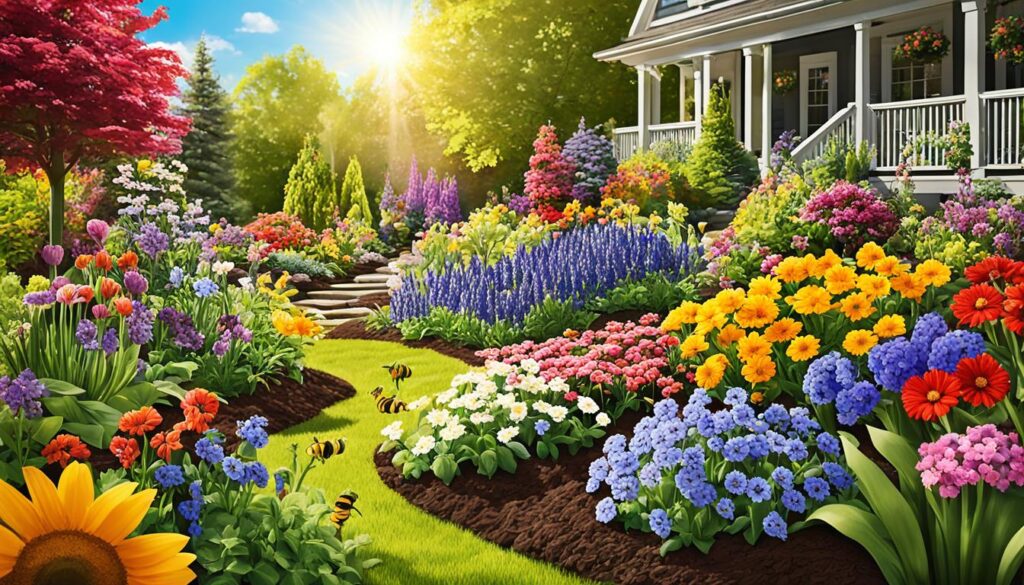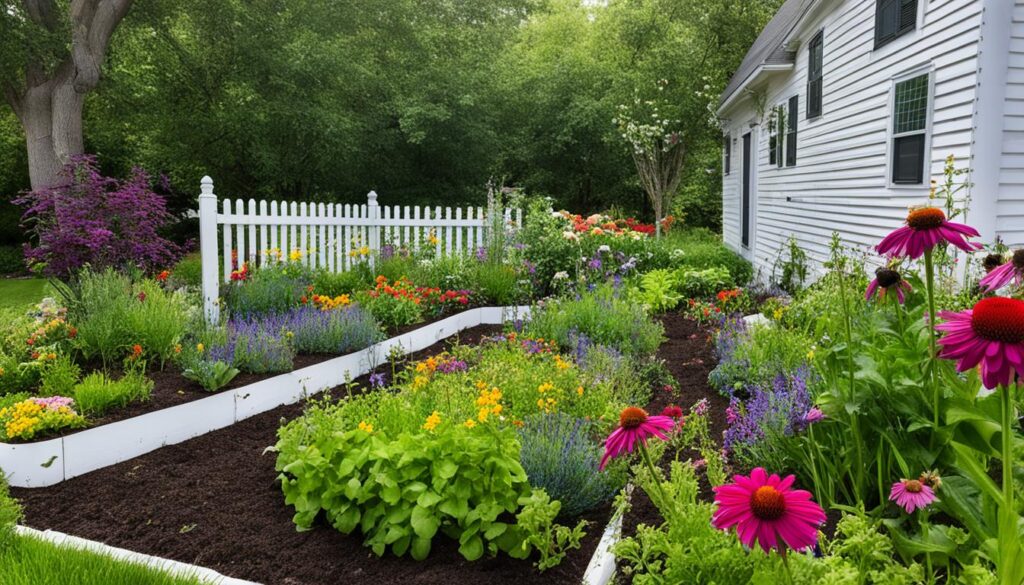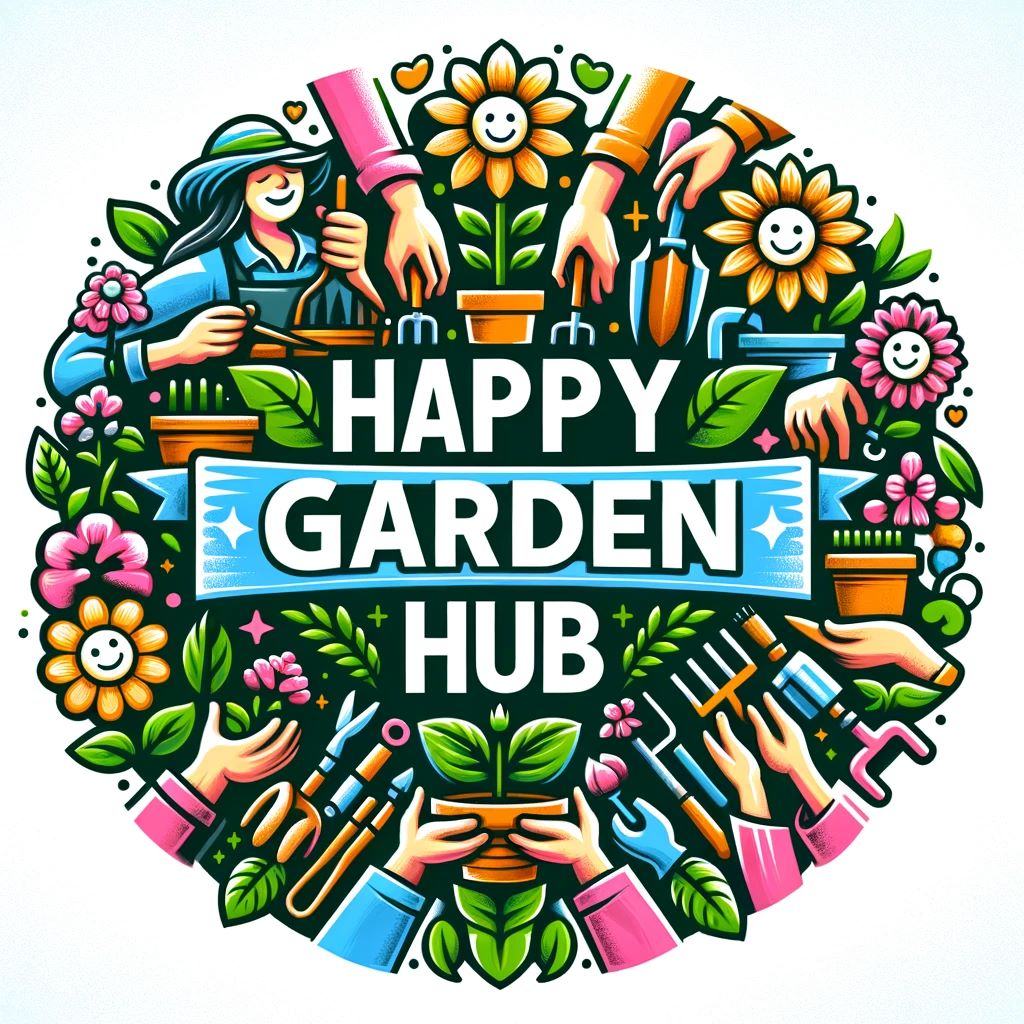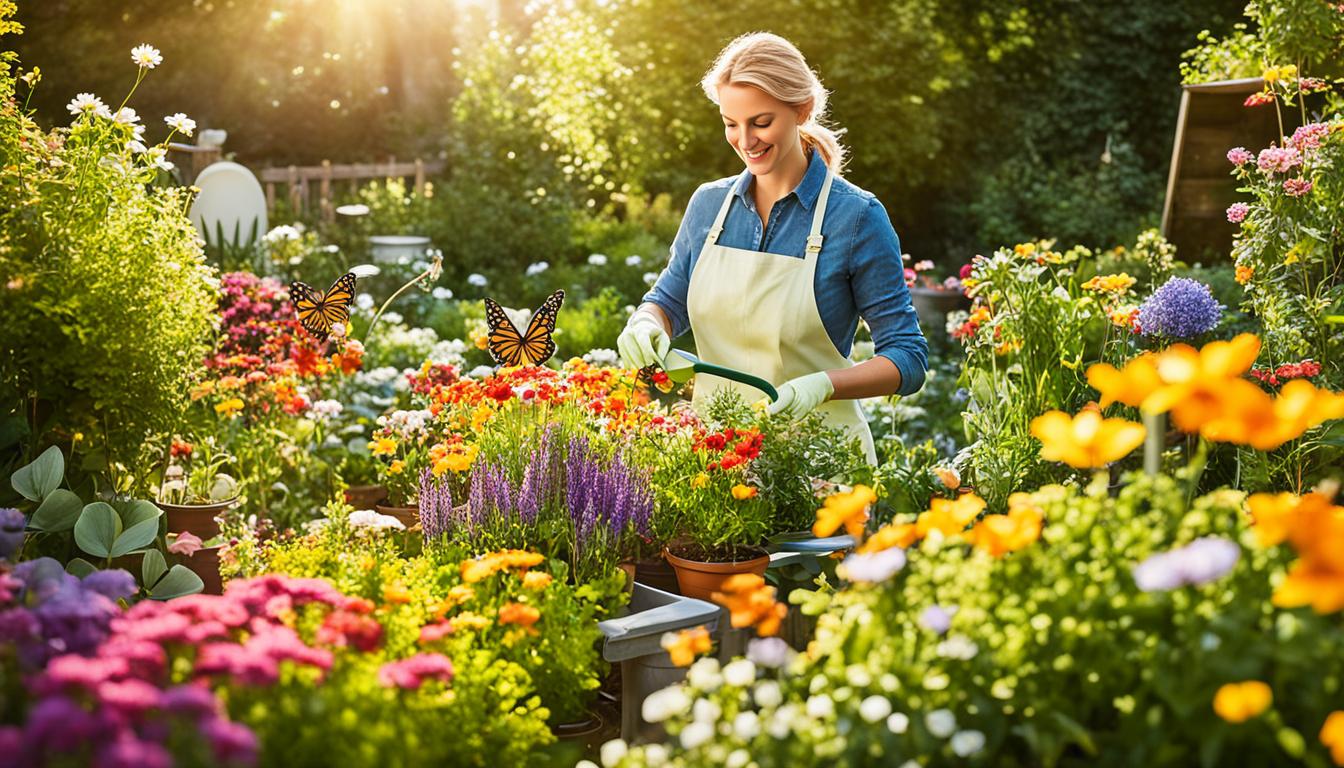This post contains affiliate links.
A garden is a friend you can always visit. The breeze whispers and flowers bloom in bright colors, showing why. Picking up a trowel and planting a sunflower wasn’t just planting a seed. I was adding joy that would grow each day. Gardening gave me peace, a break from everyday life, and a deep earth connection.
April 14th marks National Gardening Day. It’s all about the joy of planting and its many benefits. Gardens improve our lives in so many ways, from stress relief to better health. No matter your skill level, this day is for everyone to start gardening. The “Plants Aren’t Just Pretty” infographic shows plants’ positive effects on us and our environment. It encourages us to garden more. Learn more about how to celebrate National Gardening Day and be part of the green movement.
Key Takeaways
- National Gardening Day is celebrated on April 14th.
- Gardening provides stress relief and improves well-being.
- It welcomes everyone from gardening novices to experts.
- Gardens have countless environmental and health benefits.
- Engage in gardening activities to beautify surroundings.
The Importance of National Gardening Day
National Gardening Day is on April 14th. It encourages us to enjoy gardening and learn about its benefits. It helps us see how gardening connects us with nature and offers many rewards.
On this day, you can visit places like DeBary Nursery for gardening tips. Or learn at Natalia’s Garden Center in DeBary. It’s a chance to enhance your gardening skills with lots of resources.
In Central Florida, gardening season is all year. April is great for planting crops like corn and fruits such as papaya. Gardening leads to eating more fruits and veggies, which is healthy.
The U.S. Department of Agriculture suggests testing your soil. This ensures your garden is safe and rich for planting. Also, Volusia County has rules about fertilizer to protect our environment.
Using native plants is a good idea too. They need less water and care and keep pests away. This choice helps the environment and local wildlife, like butterflies and bees.
National Gardening Day is about bringing people together. It teaches kids about nature, helps us swap seeds, and beautifies our homes. It shows us the joy and healing power of nature.
Popular Garden Activities to Celebrate
National Gardening Day is the perfect time to start fun garden projects. Whether planting gardens for bees and butterflies, mixing different plants, or working on eco-friendly projects, there’s something for all. Every gardener can find joy and purpose in these activities.

Pollinator Gardens
Planting gardens for pollinators like bees and butterflies is exciting. The Ypsilanti District Library will hold a special presentation on April 22, 2023. These gardens help the environment and cut down on water and chemicals. Discover how to garden in a green way.
Mixed Plantings
Mixing different plant types is another way to celebrate. This approach boosts your garden’s looks and health. Project Grow offers classes on April 18 and May 4 with tips for mixed gardens. Diverse gardens are beautiful and good for nature.
Green Infrastructure Projects
Green projects can make cities and suburbs better. In Ann Arbor, rain gardens are becoming a favorite. There’s also a seed starting event for Earth Day at the Ann Arbor District Library. Visit the W.E. Upjohn Peony Garden in Nichols Arboretum from late May to early June. Over 270 peony types bloom there, combining beauty with eco-friendliness.
| Event | Date | Activity | Location |
|---|---|---|---|
| Pollinator Gardens Presentation | April 22, 2023 | Planting Pollinator Gardens | Ypsilanti District Library |
| Tips and Techniques 2—Planting Your Garden | April 18, 2023 | Creating Mixed Plantings | Project Grow |
| Earth Day Seed Starting | April 22, 2023 | Green Infrastructure Projects | Ann Arbor District Library |
| Native Plant Expo & Marketplace | June 3, 2023 | Green Infrastructure Projects | Washtenaw Farm Council Grounds |
| W.E. Upjohn Peony Garden Viewing | Late May – Early June | Mixed Plantings | Nichols Arboretum |
Health Benefits of Gardening
Gardening is more than a fun hobby. It brings many health benefits. It can reduce stress, boost focus, and make you feel better. Let’s explore how gardening can lead to a healthier life.
Stress Reduction
Feeling stressed? Try gardening. A 2017 study showed that gardening can lower stress. It’s calming to plant and care for your garden. A 2014 survey by the National Garden Scheme found it brings peace. Research also says it’s great for beating stress.
Improving Concentration
Having trouble focusing? Gardening might help. It needs planning and attention, which is good for your concentration. A study by the University of Essex in 2013 showed it boosts mental focus. Gardening helps you ignore digital distractions. It’s great for mindfulness and paying attention.
Enhancing Well-being
Gardening does more than relieve stress and help focus. It’s good for your overall well-being. It makes you feel accomplished and valued. A 2014 report from the Netherlands showed the importance of green spaces. Gardening combines exercise, mental activity, and emotional release. It greatly improves life quality.
Incorporating Grasses in Your Garden
Adding grasses to your garden is a great way to blend eco-friendliness with beauty. These plants cover more than 40% of Earth’s land and are popular in public and commercial spots. Yet, they’re less common in home gardens. Thanks to experts like Piet Oudolf, this is changing.
Grasses aren’t just pretty; they’re practical and promote eco-friendly gardening. The Plant Heritage National Collection highlights Deschampsia grasses at the Walled Gardens. Three types are native to Britain, perfect for wild or prairie gardens.
Some grasses, like Japanese blood grass, change color through the year, turning brighter red. Others, such as Stipa tenuissima or Mexican feather grass, sway elegantly in the breeze. Feather reed grass, known scientifically as ‘Calamagrostis x acutiflora ‘Karl Foerster”, is notable for its sturdy posture and changing seed head colors.
Garden lovers use various grasses for different spots, whether shady, wet, rocky, or dry. Festuca grasses, including ‘Golden Toupee’ and ‘Elijah Blue,’ are great for vibrant, spiked borders. Plus, these decorative grasses are easy to care for after they settle in.
Grasses do more than look good. Their deep roots stabilize soil and prevent erosion, making them great for eco-gardening. Using native grasses or hybrids that don’t seed can lower gardening’s environmental impact.
Grasses enhance biodiversity, offering homes for wildlife, insects, and birds. They keep your garden beautiful from spring to winter. Whether for their looks or environmental benefits, grasses ensure your garden is always charming.
| Grass Type | Notable Features | Ideal Conditions |
|---|---|---|
| Japanese Blood Grass | Redder as year progresses | Sunny, well-drained soil |
| Stipa Tenuissima | Captivating motion in breeze | Sunny, dry areas |
| Feather Reed Grass | Upright habit, changing seed head colors | Versatile, including wet conditions |
| Festuca (Golden Toupee/Elijah Blue) | Colorful spiky edging | Various, including dry and stony areas |
Sustainable Gardening Practices
Gardening lovers in the USA are choosing sustainable gardening practices more and more. They aim to make their gardens flourish while also caring for the planet. These practices help increase biodiversity, lower water use, and save money on garden upkeep.

Natural Landscaping
Using local plants is at the heart of natural landscaping. These plants are perfect for your area’s weather and soil. This means they need less water and fewer chemicals, which is great for the environment. Plus, they help local animals like bees and butterflies.
For places with limited funds, like nature centers, native plants are a smart choice. They make for healthier ecosystems and cut down on future costs.
Xeriscaping
Xeriscaping is key for dry areas. It uses plants that don’t need much water to survive. This way, gardeners in dry places can save a lot of water. And that’s really important in places where water is hard to come by.
Adding water-saving techniques like drip irrigation makes this even better. It makes sure plants get exactly what they need, without wasting water. This is good for the plants and the planet.
Choosing sustainable gardening is both a moral and smart financial move. By going with natural landscaping and xeriscaping, you get beautiful gardens that don’t harm the environment. Plus, you’ll spend less on keeping them beautiful.
Becoming a Backyard Farmer
Backyard farming means growing your own food at home. You can harvest tasty fruits, veggies, and herbs. It makes your space beautiful and productive. You also avoid harmful chemicals, making your food healthier.
Beginning your gardening journey might feel tough. Yet, with the right advice and persistence, you’ll see your garden thrive. Start small and choose crops you love. Learn about your area’s weather, soil, and sunlight. These are key to a successful garden. Check out this guide from Laughing Dog Farm for great tips.
Sometimes, you might run into challenges like not having enough water or supplies. But, there are many resources to help beginners. Joining gardening communities can offer support and resources. They also provide mentorship which is crucial for growth.
Gardening takes effort and sometimes things don’t go as planned. Use modern farming methods to improve your garden. Try no-till farming, sprouting, and making compost for better soil. Saving seeds from heirloom plants can also help make your garden more sustainable. Letting plants reseed themselves is good for future planting.
Backyard farming is gaining popularity, especially among new gardeners. It’s a step towards more sustainable and fair food. Small, local farms play a big role in our food’s future. They are ideal for starting your garden and helping it grow.
Experienced gardeners should help beginners. This will promote sustainable farming. So, put on your gloves, choose your seeds, and start your garden today!
| Challenges | Solutions |
|---|---|
| Lack of water, mulch, seeds | Join gardening communities for resource sharing |
| Absence of mentorship | Experienced farmers mentoring beginners |
| Uncertainty in crop cultivation | Utilize sustainable farming techniques |
The Joy of Community Gardens
Community gardens bring people together to garden as one. They create a friendly place to share tips, tools, and the happiness found in gardening. The week of June 2-8, 2024, marks National Gardening Week. It highlights these shared spaces, promoting ecological sustainability and strengthening communities.
Since 1891, National Garden Clubs have been active, with headquarters in St. Louis, Missouri, and branches in 19 states. This special week celebrates the value and joy of gardening. Gardening clubs play a key role in setting up events. The American Horticultural Society and the National Garden Bureau make sure gardening info is available to all, regardless of gardening skill.
Schools sometimes include gardening in their lessons. They teach about biology, ecology, and how food grows. Community gardens are extra helpful. They give people without their own gardens a chance to grow plants for beauty or to eat.

National Gardening Week is filled with fun events. Look for plant sales, garden tours, and workshops. These events are open to gardeners of all levels. They help everyone enjoy community gardens more. These gardens bring people together, building community spirit. They also help our planet by encouraging green living and adding to local plant life.
Here’s a look at some organizations and what they do for National Gardening Week:
| Organization | Contribution |
|---|---|
| National Garden Clubs | Orchestrates events, headquartered in St. Louis, Missouri |
| American Horticultural Society | Provides gardening resources |
| National Garden Bureau | Supports educational activities and resources |
| American Community Gardening Association | Helps with finding and making community gardens |
Plant Care Tips for Beginners
Gardening is both an art and a science for newbies. Getting the right plant care tips helps your garden thrive. Learn to pick the right plants and keep pests away with this guide.
Choosing the Right Plants
Picking the right plants is key in gardening. Different plants do well in different settings. For example, Central Florida folks can grow veggies and fruits year-round. April is best for corn, Okra, and tropical fruits like papaya and pineapple. Choose plants that match your area’s climate and soil.
Watering and Maintenance
Watering your garden right is crucial. Too much or too little water can be harmful. Knowing your plants’ water needs is important. Different gardens, like raised beds or containers, need different care. Project Grow has classes on watering and garden upkeep.
Dealing with Pests Naturally
No one likes pests in their garden. Use natural pest control to protect your plants and the environment. The Ypsilanti District Library’s Pollinator Gardens talk on April 22, 2023, teaches eco-friendly pest management. These methods help your garden and the planet.
Boost your gardening knowledge and community ties. Don’t miss the Native Plant Expo & Marketplace on June 3, 2023, at the Washtenaw Farm Council Grounds. Discover sustainable gardening and get new plants for your garden.
Indoor Gardening Options
Creating an indoor garden is perfect for those without outdoor space. Growing plants inside is getting popular. It makes your home greener and improves air quality and well-being. Let’s look at some top indoor gardening examples and methods.
Plants that Thrive Indoors
Choosing the right plants is key in indoor gardening. Many plants do well inside with little care but bring big benefits. Here are some great choices:
- ZZ plants
- Peace lily
- Philodendron
- Spider plant
- Snake plant
- Alocasia
- Calathea
- Dracaena
- Monstera
- Pothos
- Nerve plant
- Caladium
- Calla lily
- Various herbs like basil, mint, and cilantro
These plants are tough and handle different indoor settings well. They’re good for both experts and newbies.
Container Gardening
Container gardening is great for city folks. Use pots and planters to create a garden on balconies, patios, or window sills. Choose containers with drainage that fit the plant’s root size. Here’s how to do it:
- Make sure containers have holes to avoid water excess.
- Choose top-quality potting soil, like Miracle-Gro® Performance Organics® All-Purpose Container Mix, for healthy plants.
- Keep a regular watering routine; test soil moisture an inch deep.
- Feed plants weekly with Miracle-Gro® Performance Organics® Edibles Plant Nutrition for strong growth.
With the right care, you can grow edible plants inside too. This includes lettuce, tomatoes, peppers, and more. You get the benefits of indoor veggie gardening.
| Plant Type | Light Requirement | Watering Frequency |
|---|---|---|
| Herbs (Basil, Mint) | 4-6 hours | Once a week |
| Leafy Greens (Spinach, Kale) | 4 hours | Once a week |
| Fruit Vegetables (Tomatoes, Peppers) | 6-8 hours | Twice a week |
Indoor gardening lets you create a peaceful space. It also puts you in charge of growing your own fresh food all year.
Conclusion
National Gardening Day falls on April 14th every year. It’s a celebration of gardening’s beauty and benefits. The Garden Writers Association created it in 2013. It encourages people of all skill levels to enjoy gardening. Visit National Gardening Day to learn more.
Gardening does more than improve our health. It also helps the community and the environment. Events like National Pollinator Week, World Environment Day, and International Compost Awareness Week show this. They highlight how gardening connects us to the earth all year round.
National Gardening Day is a meaningful movement. It brings beauty and energy into our lives. Whether in a big community garden or a small indoor space, every bit helps. This April, let’s celebrate the importance of gardening in our lives. It builds community and takes care of our planet.
FAQ
What is National Gardening Day?
How can I celebrate National Gardening Day?
What are the health benefits of gardening?
How can I incorporate grasses in my garden?
What are some sustainable gardening practices?
How do I start a backyard farm?
What is the importance of community gardens?
What are some plant care tips for beginners?
What are some indoor gardening options?
This post contains affiliate links.

